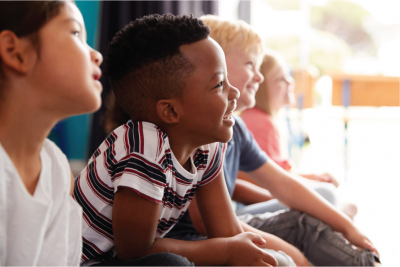10 Tips for Fostering Social and Emotional Intelligence in Young Learners

What Is Social and Emotional Intelligence?
Young children deal with many of the same emotions adults do. Children get angry, sad, frustrated, nervous, happy, or embarrassed, but they often do not have the words to talk about how they are feeling. Instead, they sometimes act out these emotions in very physical and inappropriate ways
Social and emotional intelligence is the set of abilities that allows people to work with others, learn effectively, and play important roles in their families and communities. Many studies show that IQ (intelligence quotient) is only a minor predictor of success in life; social and emotional skills are far better predictors of both success and well-being.
While there is a developmental time line of stages in social-emotional growth, not all children reach each milestone at the same time. Young children need lots of opportunities to talk about their feelings and practice controlling impulses and getting along with others in a safe, supportive environment. As they get older, they also need encouragement to set and reach goals, whether it’s writing their names, learning to whistle, or helping build a birdhouse.
The National Association for the Education of Young Children provides the following guidelines to help families, caregivers, and teachers foster social-emotional intelligence:
Make sure children have varied opportunities to . . .
- Engage throughout the day with [adults] who are attentive and responsive to them, facilitate their social competence, and facilitate their ability to learn through interacting with others
- Recognize and name their own and others’ feelings
- Learn the skills needed to regulate their emotions, behavior, and attention
- Develop a sense of competence and positive attitudes toward learning such as persistence, engagement, curiosity, and mastery
- Develop skills for entering into social groups, developing friendships, learning to help, and other pro-social behavior
- Interact positively, respectfully, and cooperatively with others; learn from and with one another; and resolve conflicts in constructive ways
- Learn to understand, empathize with, and take into account other people’s perspectives
Tips to Foster Social-Emotional Intelligence in Young Learners
The following are some tips and activities to help the young learners in your life develop their social and emotional intelligence.
- Simon Says
Play a social-emotional version of “Simon Says” by giving instructions such as “Simon says to act mad,” “Simon says to act silly,” “Simon says to act proud,” etc. Be sure to take turns being Simon!
- Deep Breathing
One of the most effective techniques for self-calming at any age is to take several slow, deep breaths. This helps counteract the quick, shallow breathing we often experience when we’re upset and brings more oxygen to the brain, which helps us respond to the situation in a more relaxed frame of mind.
- Sentence Frames
Encourage children to talk about difficult situations using simple sentence frames such as “I feel mad because ___” and “I would feel less mad if ___.”
- I Can Use Big Words!
Teach children words that represent social-emotional skills. For example, “Your block tower fell down, but you built it again a different way. Now it’s even taller than before! You really know how to persevere!” Soon they will internalize this positive vocabulary and begin using the words independently.
- Dolls, Puppets, and Stuffed Animals
Use children’s toys to make up stories, reenact an event, or demonstrate ways to be kind or resolve conflicts. Be sure to invite them to join in the play!
- Children’s Literature
Children’s stories involve characters who experience a range of emotions while solving various problems. While enjoying a story together, discuss the characters’ feelings and study the illustrations for clues, such as facial expressions and body language. Then, when discussing the story afterward, recall times when you’ve felt that way and/or how you would feel and what you would do in a similar situation. Picture books are also a safe way to explore topics that concern young learners, such as bullying or welcoming a new baby into the family.
- Paper Plate Faces
Using small paper plates, help children draw faces that express various emotions, such as happy, sad, mad, worried, frightened, proud, jealous, silly, surprised, excited, embarrassed, determined, and relaxed. If you have craft sticks, you can tape those to the lower back of the plates as well. Children can use these simple face puppets for dramatic play and to identify emotions they feel and see in others. You can also use the plates for a game of charades by secretly selecting one of the faces and acting it out using facial expressions and other actions (pretending to cry, jumping up and down, etc.).
- “Give Me Five!” Problem-Solving
Teach children to “give me five” when problem-solving. Hold out one hand and count off the fingers with the other hand as you go through the following five steps together. By doing this, you’re helping your child learn HOW to think, not WHAT to think!- Name the problem. For example, “Joey wants the truck, but I’m playing with it.”
- Tell how you feel.
- Think of two possible solutions.
- Talk about how each solution might turn out.
- Decide which solution to try.
- As children gain proficiency, be sure to praise them when they solve a problem independently—negotiating with a friend, moving so he/she can see something better, putting on a sweater when cold, pulling over a step stool to reach a light switch, etc.
- Breaking or Bending
If your young learner has trouble adapting to situations that don’t meet his or her expectations, try the following object lesson.- Hold up a craft stick. Talk about how some people get upset every time something doesn’t go exactly as they want it to. Then they just snap! Bend the craft stick until it snaps into two pieces.
- Hold up a bendable chenille stick. Introduce the word “flexible” and bend the chenille stick around to demonstrate the word’s meaning. Then talk about how some people are flexible because they can bend and change when they need to. Point out that when everyone is flexible, the whole group is happier and can still have a good time.
- Share times in your own life when you’ve been a craft stick and snapped or a chenille stick, bending as needed and then straightening back out.
- Praise your learner for being flexible in unexpected circumstances.
- Take It Beyond
In addition to the above, please remember that opportunities for growth and practice occur throughout the day. During dramatic play? Check! While riding in the car? Check! While creating a craft project or playing a game outdoors? Check! It even happens while going out for a hamburger, doing chores, and getting ready for bed! So look for ALL the “teachable moments” that occur each day while trying out these tricks of the trade.











Comments